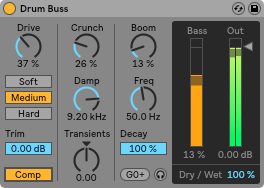Ableton Live 10.1- What’s New- Wavetable Synthesis User Waves

Recently Ableton announced a free update to Live – Version 10.1
There were a number of workflow improvements , but one of the major new features is the Wavetable synthesizer now supports user wavetables. This allows you to import any wavetable or sample and use it as an oscillator.
Check out this Youtube video of everything that’s new in Live 10.1.
Wavetable synth architecture
Wavetable has a dual-oscillators plus a sub-oscillator this feeds into a 2-pole lowpass filter with five different types of resonant multimode filters available for each of its two filters: Clean , OSR (based on the Oscar), MS2 (a model of the Korg MS20), PRD (based on the Moog Prodigy) and SMP (a variation of the Sallen-Key topology). The MS2, PRD, SMP, and OSR modes are switchable between lowpass and highpass, with variable Drive for adding grit.
There are tons of preset wavetables already organized into categories- Basics, Collection, Complex, Distortion, Filter, Formant, Harmonics, Instruments, Noise, Retro, and Vintage. You can pretty much guess what is in the Presets from the category names.
Wavetable synthesis was used in Ensoniq, Korg, PPG and many other synthesizers. It can also do FM-like synthesis.
Wavetable synthesis is fundamentally based on periodic reproduction of an arbitrary, single-cycle waveform.[5] In wavetable synthesis, some method is employed to vary or modulate the selected waveform in the wavetable. The position in the wavetable selects the single cycle waveform. Digital interpolation between adjacent waveforms allows for dynamic and smooth changes of the timbre of the tone produced. Sweeping the wavetable in either direction can be controlled in a number of ways, for example, by use of an LFO, envelope, pressure or velocity.
by Wikipedia
You can achieve familiar FM effects by starting with the Sines 1 table in the Harmonics category (with a wave position of zero; pure sine), then adjusting the modulation amount parameter with an envelope. The tuning hot spots, where the FM effect retains harmonic coherence (without dissonant artifacts), are -100%, -50%, 0, 50%, and 100%. These correlate with ratios of 0.25:1, 0.5:1, 1:1, 2:1 and 4:1, respectively. Between those values, the Sines 1 sine wave is a fantastic resource for organic bell and mallet textures. Because FM is more controllable with simple carrier waveforms, complex wavetables will yield results that are more unpredictable.
by Ableton’s Lead preset designer and soundteam member Huston Singletary
Wavetable’s enevelopes give you temporal control over the shape of the sound. Envelop 2 is a very typical acoustic sound that might be used for a Piano. Envelope 3 is a very short percussive sound.
One of my favorite techniques is to apply velocity to envelope 2 or 3’s peak parameter, which serves to tie that envelope’s modulation amount to the impact of hitting a key or Push pad.
by Ableton’s Lead preset designer and soundteam member Huston Singletary
Of course Wavetables really come alive when you move through the single cycle wave forms which creates timbral changes. The Prophet VS and PPG were some vintage synths that really showed these capabilities off.
One of my favorite techniques for adding vintage animation to our wavetables is to modulate the PW parameter gradually for only one oscillator with a very slow triangle or sine LFO playing against a second oscillator, with Osc 2’s PW base value set to none or its FM amount slightly raised.
by Ableton’s Lead preset designer and soundteam member Huston Singletary
Ableton of course added other features to Ableton 10.1 including a Channel EQ.
New automation features
Musicians get a palette of automation shapes to choose from, as well as the ability to stretch and skew automation, enter values with the numerical keypad, and easier access to clip modulation in Session View. Live now also detects curved movements inside automation and can merge multiple breakpoints into C- and S-shapes.
by Ableton

New in Live: Discover the new features Ableton Live 10 has to offer | Ableton






